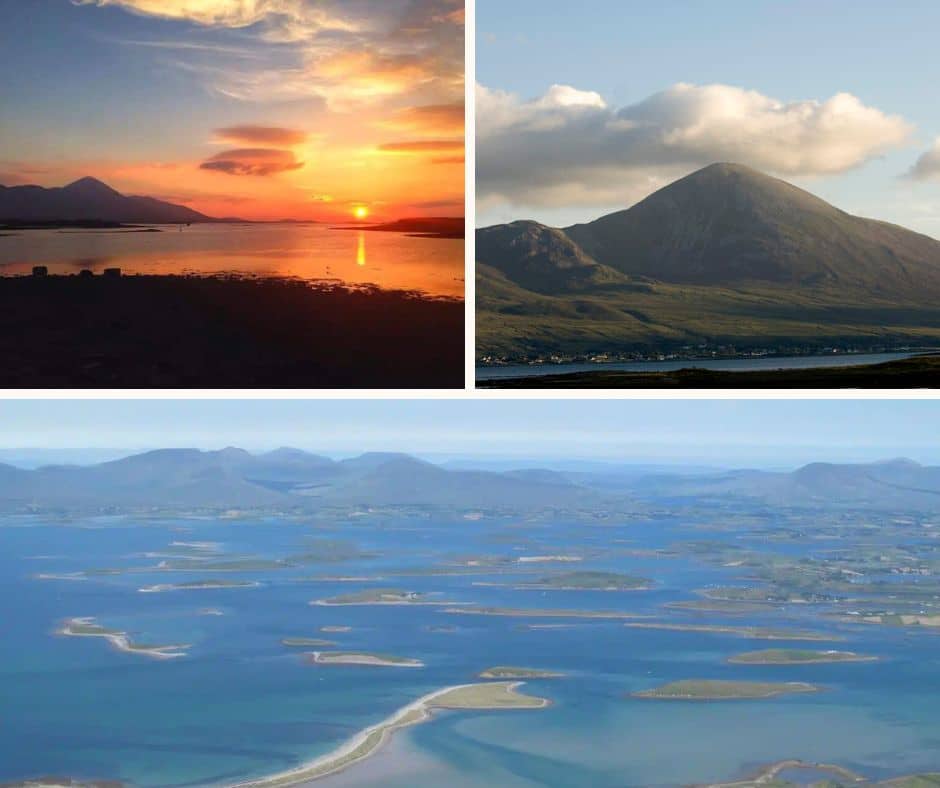
Croagh Patrick, or The Reek as it’s known locally, is one of Ireland’s most recognisable and revered mountains.
The mountain, located near Westport in western County Mayo, offers those who climb its steep slopes spectacular panoramic views of Clew Bay and its 100s of islands.
It’s a place that means different things to different people, some climb it for the tradition, others for the challenge, and many for the views. I’ve climbed it over 15 times now, in all sorts of weather, and it’s a hike that still draws me back.
In this post, I’ll walk you through what to expect on the climb, share a few tips from experience, fill you on on the new path, and hopefully help you decide if it’s the right hike for you.
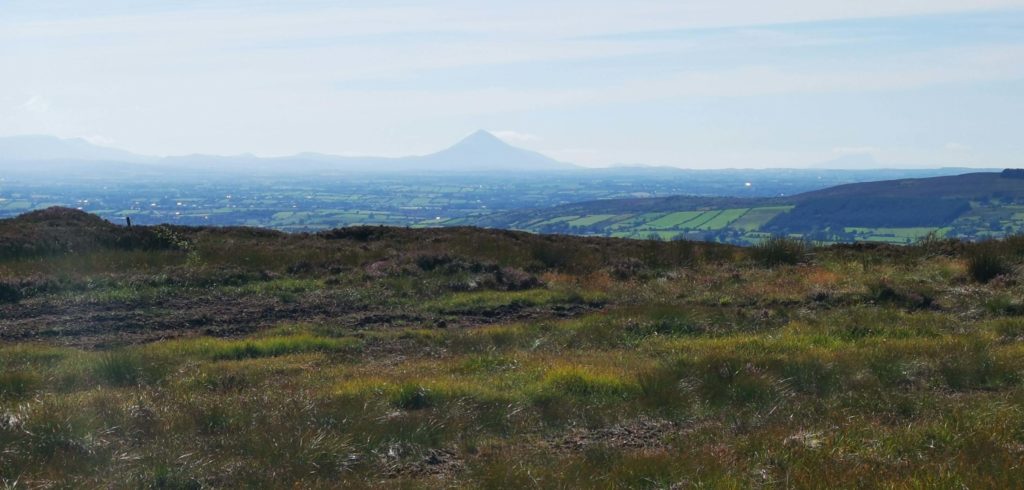
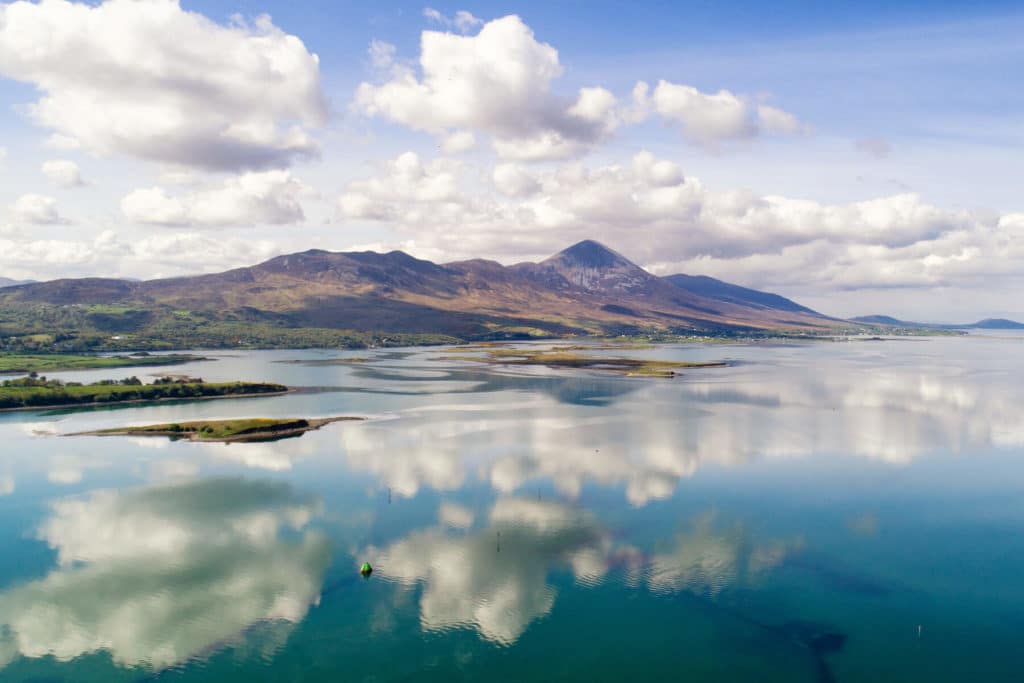
Here’s a short video to set the scene:
Introducing Croagh Patrick
Before we get into the ins and outs of climbing Croagh Patrick, we’d like to share some details about its location, parking and also some fascinating details about the mountain itself, its history and its cultural and religious significance.
Let’s get into it..
Skip straight to the hiking guide here if you wish. Otherwise, read on to discover some fascinating background information about Croagh Patrick.
Location
Croagh Patrick is located approximately 8 km west of the town of Westport, County Mayo, Ireland.
The mountain is located on the southern shores of Clew Bay, near the village of Murrisk.
Its summit offers commanding views of he Clew Bay area, as well as many distant geographical features such as the Nephin Beg mountains, the Connemara mountains and the islands of Clare Island and Achill, to name but a few.
How high is Croagh Patrick?
Croagh Patrick (Irish: Cruach Phádraig) rises to a total height of 764 metres (2,507 feet) making it the 8th highest mountain in County Mayo and the 29th highest in Ireland.
How to get to Croagh Patrick
The most popular way is by car.
From Westport town centre, it’s a good 30-40 minutes by bicycle, mostly flat and with the first section on a cycle lane (Greenway) along the main road.
Bus Eireann’s 450 service runs from the town of Westport to Croagh Patrick (stop: Murrisk). Check the timetable here.
Parking
The main car park is located at the base of the mountain, which is also the trailhead. There is a small fee to pay and can accommodate hundreds of cars.
Parking along the main road leading to the main car park can get very busy during the summer, sometimes making access to the nearby famine memorial difficult.
We recommend arriving early to secure a parking spot and paying the small fee, especially during peak season or on weekends.
During the annual Reek Sunday pilgrimage, the nearby farmers open their fields for parking, which is perfectly organised with stewards etc.
The Name
The word ‘Croagh’ is the anglicized version of ‘Cruach’, the Irish word for mountain.
‘Patrick’ relates to the patron saint of Ireland, who in 441 AD, climbed to the top of the mountain, where he set up ‘camp’ and fasted for 40 days and 40 nights. We’ll get on to Patrick a little later.
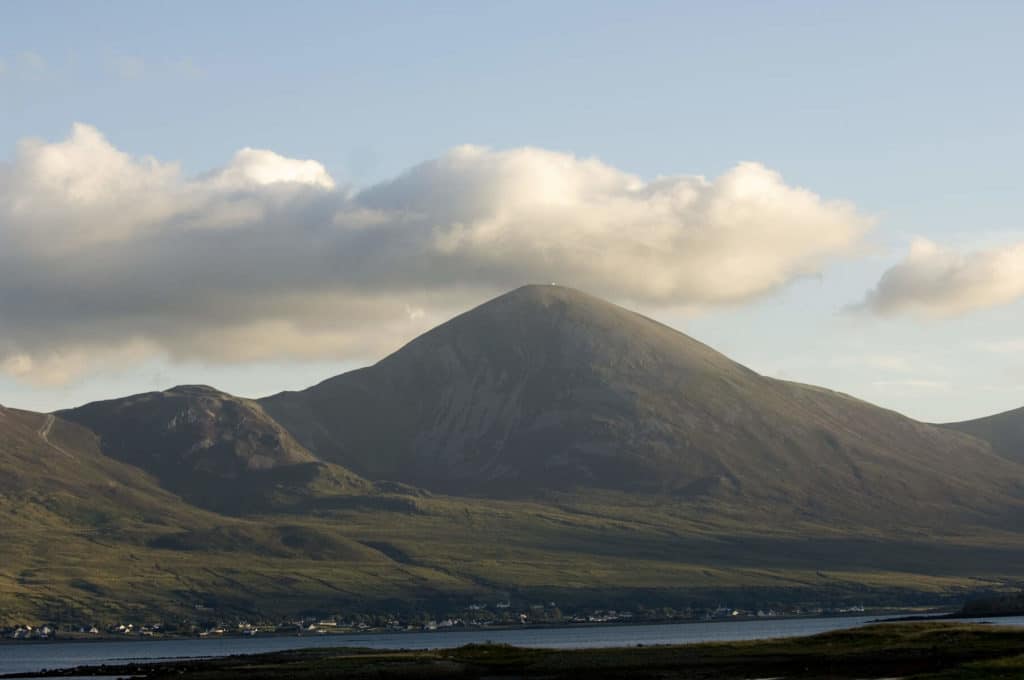
History of the mountain
The Celts
Croagh Patrick is considered one of the most significant pilgrimage sites in Ireland, with a history of religious significance that dates back thousands of years.
The mountain has been a site of worship and pilgrimage since pre-Christian times, when it was believed to be the dwelling place of the Celtic god Lugh.
To mark the beginning of the harvest, the ancient festival of Lughanasadh, The Celts climbed the mountain in honour of the God.
They named the mountain ‘Cruachan Aigle’, which translates as ‘Eagle’s Mountain’.
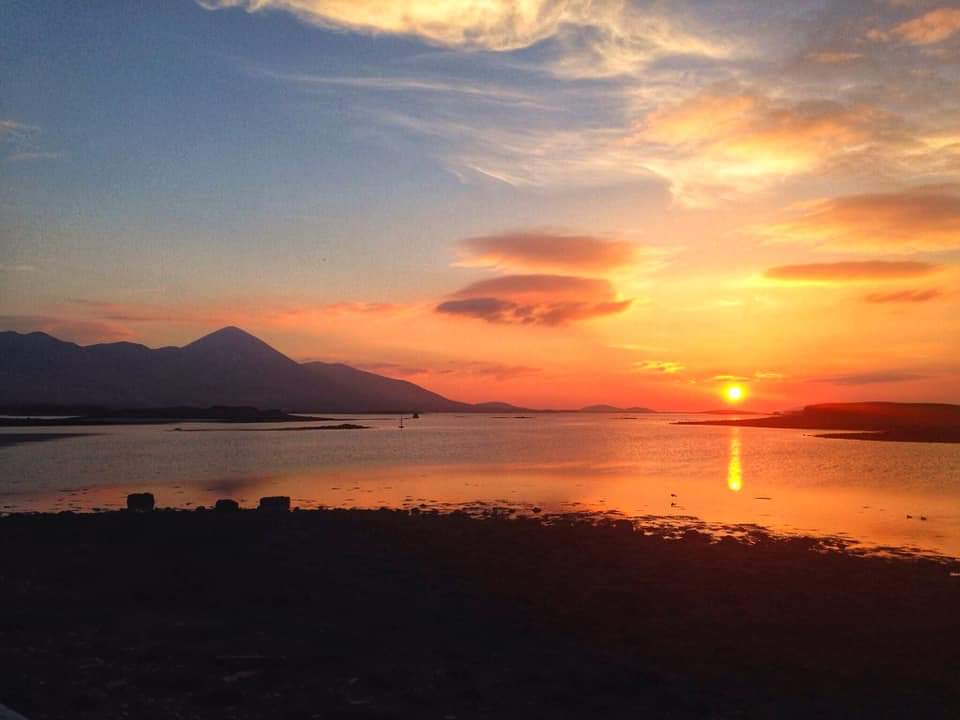
The Story of St. Patrick’s Pilgrimage
The mountain’s prominence in Irish mythology continued through the Christian era. As alluded to, it is the site where St. Patrick fasted in 441 AD, following in the footsteps of Moses and Jesus Christ.
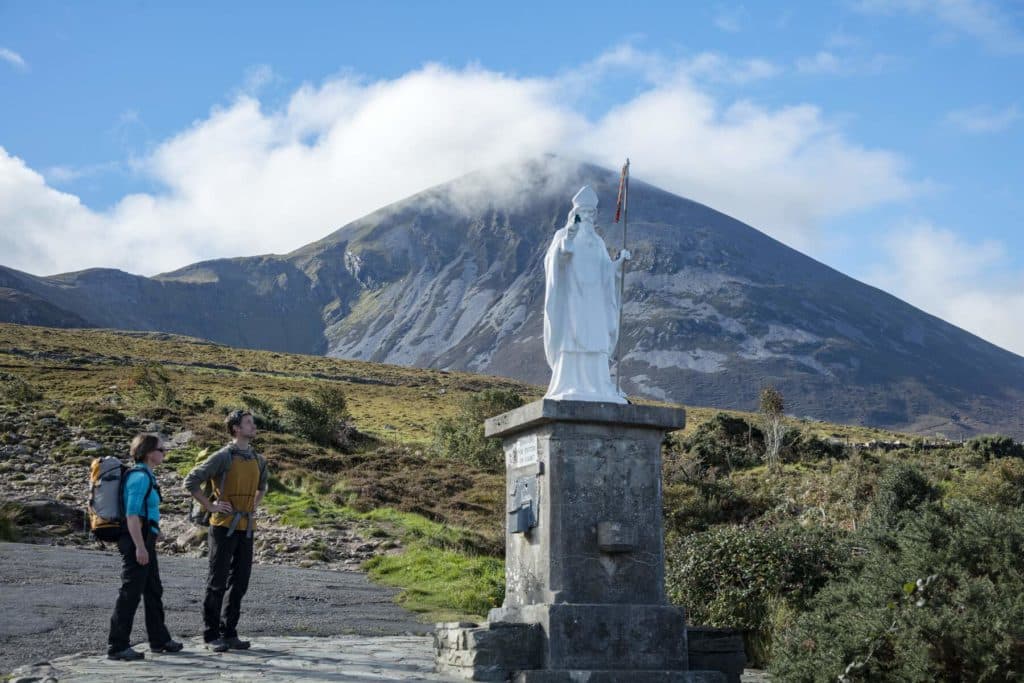
It is on top of Croagh Patrick where St. Patrick is said to have driven all snakes out of Ireland, after being confronted by a demonic serpent, which he banished to the nearby lake of Lough na Corra.
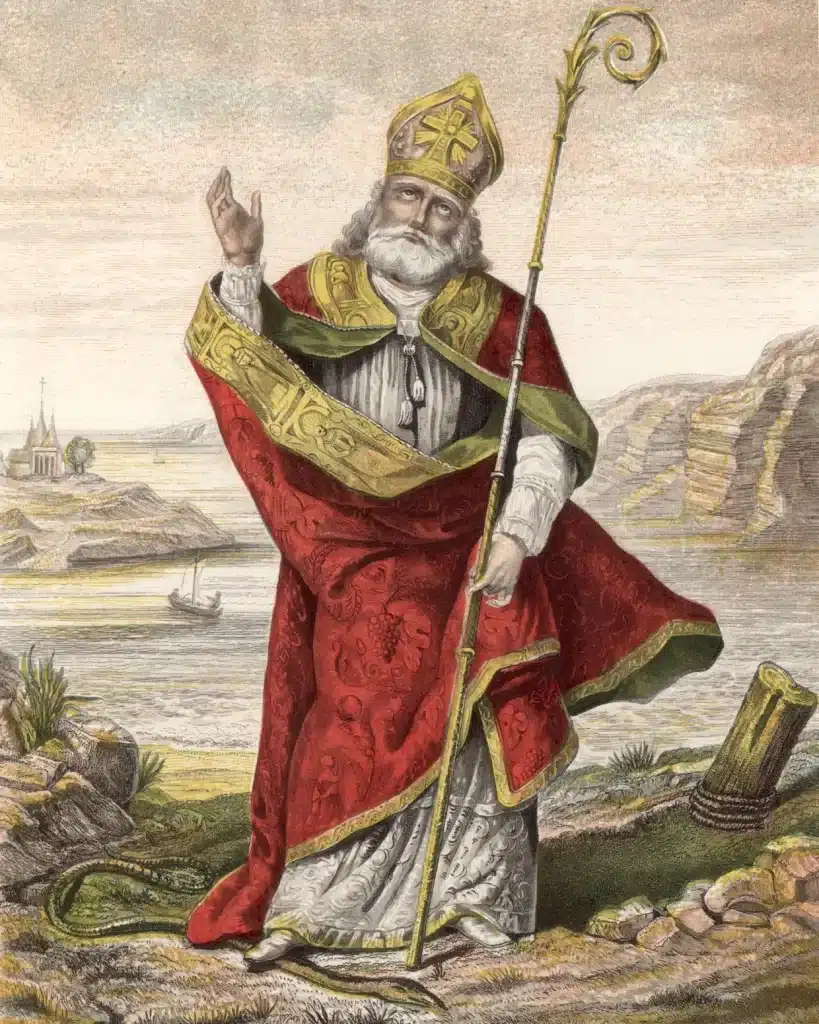
It is in fact claimed that Patrick was confronted by countless demonic creatures while fasting on the Reek, all of which were disguised in the form of animals or birds, such as ravens.
By overcoming these numerous tests of faith, an angel is said to have appeared to him.
As a reward for his immense faith and courage, the angel informed Patrick that the Irish would indeed be converted to Christianity before Judgement Day.
St. Patrick was therefore credited with converting Ireland to Christianity, and his association with the mountain has helped to establish Croagh Patrick as a place of great spiritual significance for Catholics and indeed anyone of Christian faith.
Geology/Geography
Rock types
Croagh Patrick is composed of quartzite rock, which dates back to the Precambrian era, 750 million years ago. The rock is hard and resistant and the main bulk of the mountain itself is derived from one mass of quartzite.
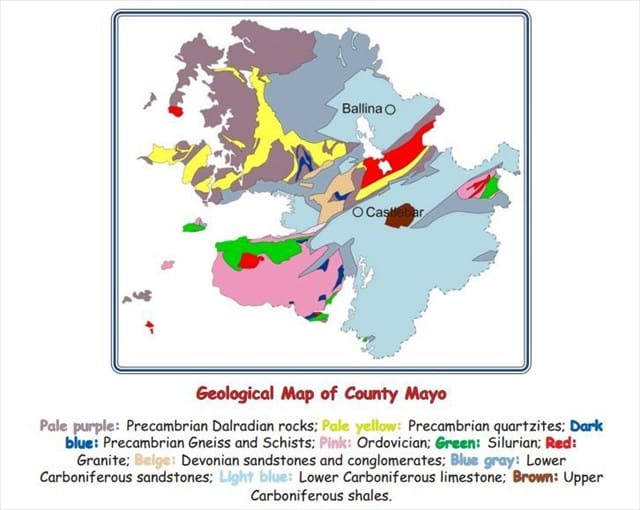
On the lower slopes of the mountain, the predominant rock is peridotite, which when in contact with the elements turns green, becoming serpentine.
On the first part of your hike, keep your eyes peeled and you’ll notice this wonderful green mineral.
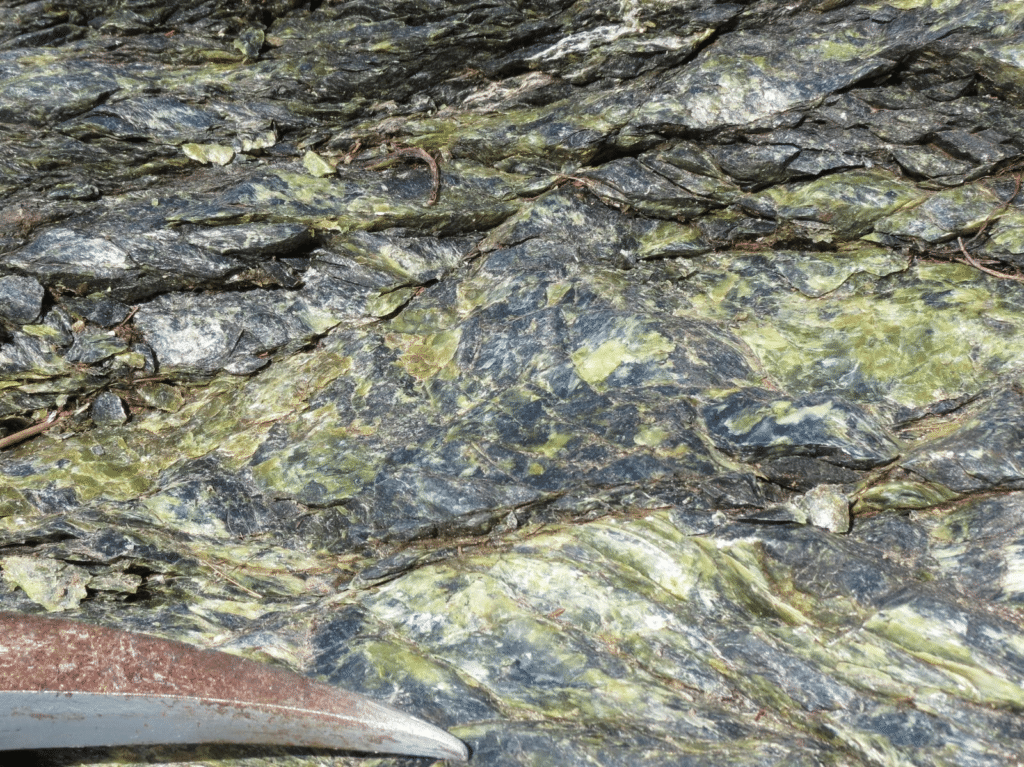
Ice Age
The mountain has a distinctive conical shape that was formed by glaciation during the last ice age, around 10,000 years ago.
The glaciers eroded the rocks on the mountain and left behind large boulders and loose debris, creating the steep sides that the mountain is known for today.
A large glacier would have existed on the colder northern side of the mountain, which tracked down into Clew Bay during the last ice age. The distinctive U-shaped valley marks the precise location.
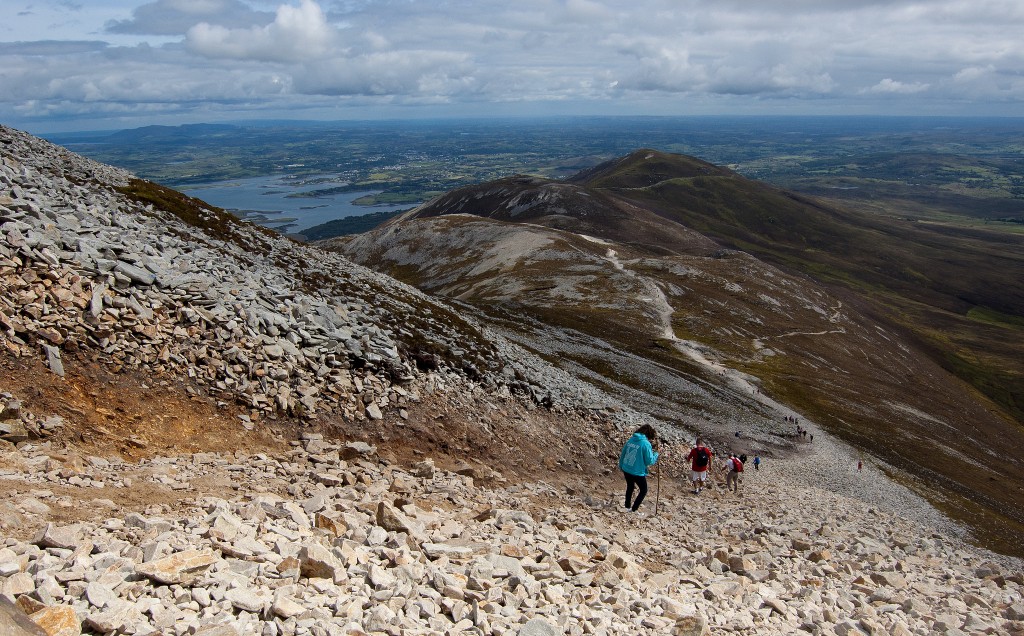
To a lesser extent, there is still evidence today of freeze-thaw action along the steep northern slopes. Here you will notice ‘scree’, loose stones resulting from pressure-inducing shattering of larger rocks.
Gold Discovery
In the 1980s, seams of gold across 12 veins of quartzite were discovered on the mountain. The value of such a quantity of gold (300,000 troy ounces) caused quite a stir in the area.
However, in order to extract the gold (which held a value of hundreds of millions) it meant that some serious excavating would have to take place, which included the use of toxic chemicals, such as cyanide.
This was met with massive objection locally, lead by the head of the Mayo Environmental Group, Paddy Hopkins. The effects of such an excavation would have had detrimental effects on the local environment.
Also, the scared nature of the mountain was another huge deciding factor in the failure of this operation. The idea of Croagh Patrick becoming a goldmine quickly dissipated by the end of the decade.
Reek Sunday
Reek Sunday is an annual pilgrimage to the summit of Croagh Patrick. The pilgrimage takes place on the last Sunday in July and has been a tradition for over 1,500 years.
The tradition is said to have started when Saint Patrick climbed the mountain and spent 40 days and 40 nights fasting there. Today, tens of thousands of people make the pilgrimage to the summit of Croagh Patrick, many of them barefoot or carrying stones as a sign of penance.
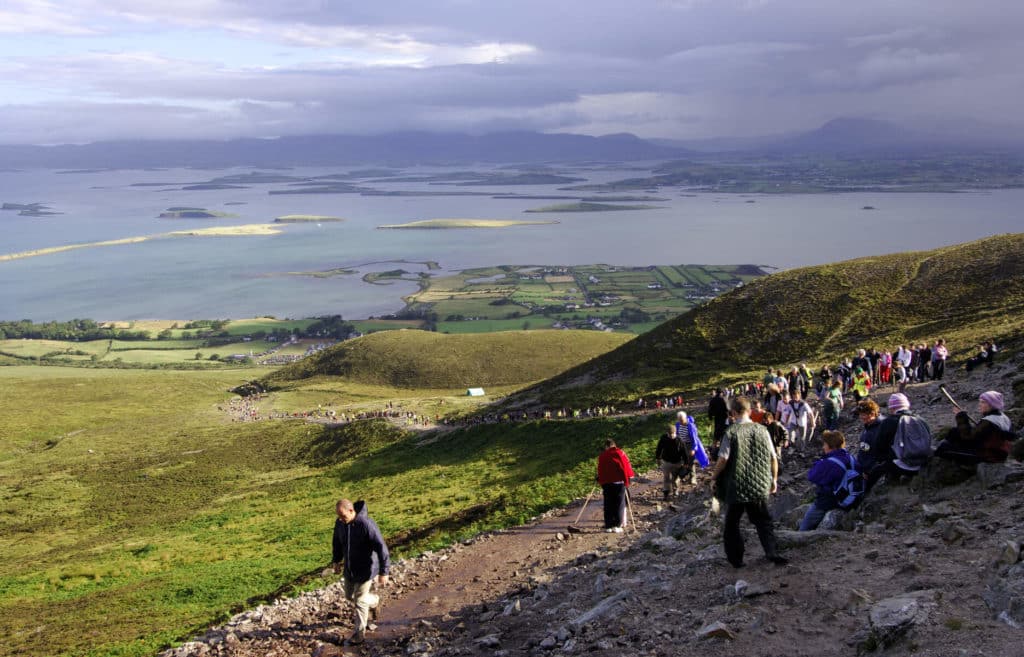
The pilgrimage is seen as an important act of devotion and spirituality for many. The day is also marked by a religious service in the chapel on top of the mountain.
The Croagh Patrick Pilgrimage: A Personal Anecdote
Having grown up in County Mayo, the Croagh Patrick pilgrimage was always a hot topic of conversation around the end of July. Around this time of the year, my grandmother used to tell me of her own annual trip to the mountain when she was young.
It entailed getting up in the middle of the night, cycling the 45 km (28 miles) to Croagh Patrick on a High Nelly bike, climbing the Reek barefoot in complete darkness and cycling back home straight away afterwards.
I always asked, ‘Was it not pure torture?’ To which she always responded, ‘Sure, we all went around barefoot those days!’
Different times.
The Church at the Summit
The church on Croagh Patrick, also known as St. Patrick’s Oratory, is a small chapel located at the summit.
The chapel was built in 1905 and serves as a place of worship and refuge for pilgrims who make the climb to the mountain’s peak.
The simple stone structure has a small altar, stained glass windows, and a statue of St. Patrick. It is open to visitors during the summer months.
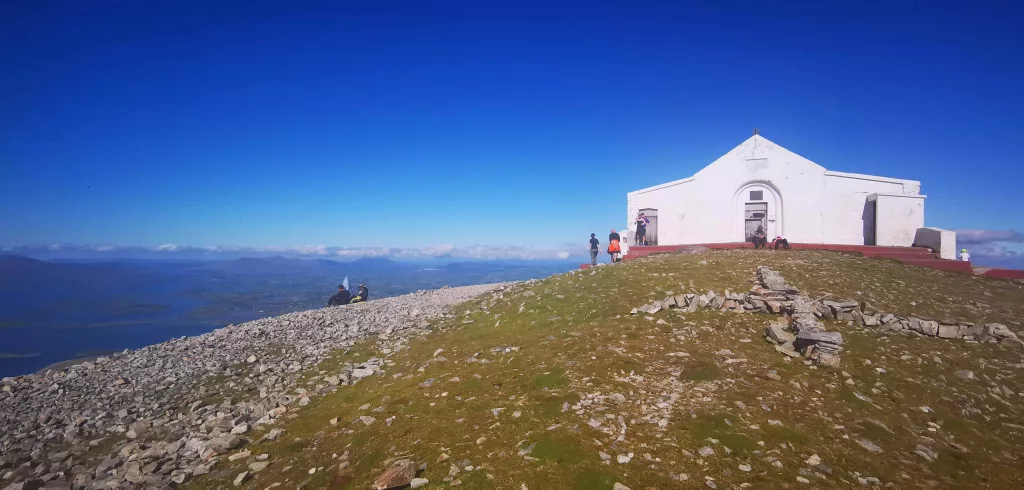
Croagh Patrick Facts, Hike Distance & Difficulty
Height: 764 metres (2,507 feet)
Elevation Gain: 742 metres (2,434 feet)
Hike Distance: 11.08 km (6.9 miles)
Hike Difficulty: Difficult
Hiking Time: 3.5-5 hours
Important info before you start the hike
Is climbing Croagh Patrick difficult?
Most people will find it a long and difficult hike, although the path on the final section (The Cone) has recently been made significantly safer with the installation of natural steps. Choose a clear, dry day for best hiking conditions and wear sturdy footwear.
The trail we will be covering is the most popular and accessible Croagh Patrick Pilgrim Trail, also known as Tóchar Phádraig.
Alternative routes to the summit: The mountain can also be accessed via the peak directly west of Croagh Patrick, Ben Goram (559 m) Another alternate route is south of the mountain, starting at the Mayo Mountain Rescue station, where you will eventually meet up with the Pilgrim Trail. The path here is regarded as steep before joining up with the main ridge.
Traditionally, the Pilgrim Trail starts at Murrisk Abbey, directly next to the car park. We have divided the climb into 4 sections, the first being very short; just to the statue of Patrick.
The ‘real’ climb is divided into 3 main sections. The first section is moderately difficult and in some sections needs a little care, as it’s quite steep.
The middle section, known as ‘the shoulder’ gives a nice respite and is mainly flat.
The final section is where things gets a lot steeper and extra care is needed here. This used to be full of loose stones (scree) but is now an excellently crafted stepped path.
Have a look here at the 4 sections of the Croagh Patrick climb, along with their level of difficulty:
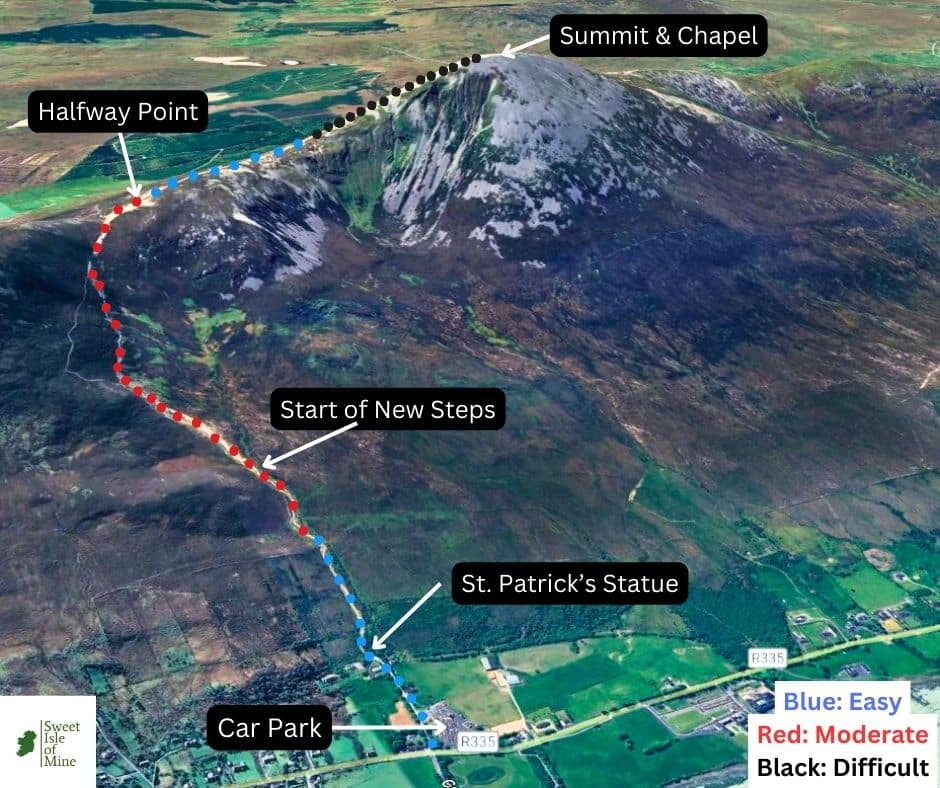
All 4 sections are covered in detail below.
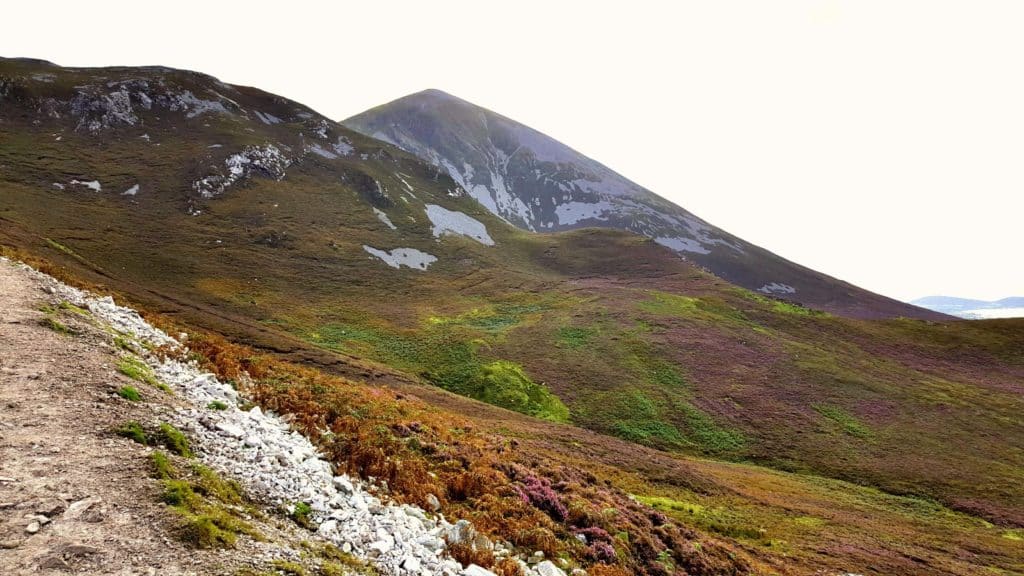
The path to the the top is very direct with essentially no zig-zag pathways.
This is overall a very common feature on Irish mountains, and those used to the carefully planned pathways, for example in the Alps, may even find the ascent to Croagh Patrick tiring.
How many miles is it to the top of Croagh Patrick?
From the carpark at the base of the mountain to the summit of Croagh Patrick and back again, the fitness tracker I used measured an exact total distance of 6.9 miles, or 11.08 km. That’s 3.45 miles (5.55 km) to the top.
Weather
Choose a clear, dry day for the hike. The mountain is located right on the coast meaning weather can change in an instant.
We have climbed Croagh Patrick in every season, in fact one of the best experiences I had was at the end of March. It was a crystal clear day, about 10 degrees and felt surprisingly warm at the top with no breeze.
Due to the very large crowds which visit in the busy summer months, if possible, we would recommend climbing during the spring (March, April, May) or autumn (September, October)
If you are already based in Westport, you’ll be able to make a good calculated bet on whether you should tackle Croagh Patrick or not. The mountain is clearly visible from everywhere in the town and beyond. The forecast for the next days is the following:
MURRISK WEATHERWhat to wear/bring for the hike
Waterproof hiking boots (a shoe that comes up over the ankle we highly recommend)
Water
Snacks (eg sandwiches, nuts, fruit)
Waterproof hiking trousers
A light rucksack
Raingear
Camera/Phone
Change of clothes if necessary
Warm gear depending on time of year/down jacket or similar lightweight warm jacket/cap
Walking Poles or a stick which is available for rent near the Visitor Centre (cost last time I visited was 4€, you get 2 back on return)
Sunscreen (don’t laugh – you’ll get sunburned on a warm day up here, no doubt!)
Are there toilets at Croagh Patrick?
Yes, there are toilets in the carpark and summit.
Is there food/drink at Croagh Patrick?
No, you’ll have to bring your own water and snacks. However, in the carpark at the base of the mountain, you’ll spot a small stone building. This is Murrisk Cafe and they serve a variety of cold and hot drinks, along with homemade food. You can also buy local souvenirs. The opening times are as follows:
Between 10.00am and 5.00pm: April to October
Between 10.00am and 3.00pm: November to March
What level of fitness is needed for Croagh Patrick?
A general good level of health and fitness is required to climb Croagh Patrick. The last section will get the heart going no matter what level of fitness.
What age to climb Croagh Patrick?
As long as those wishing to climb Croagh Patrick are in good physical condition, have no fear of heights and have a good level of overall fitness, age should not be a factor.
We do advise against young kids climbing Croagh Patrick. On our most recent climb the youngest kids at the summit were about 10 years old. For kids under this age, the hike will be too long and dangerous, due to the steepness of the last section and children may find this overwhelming.
However, we have seen kids as young as 5 or 6 climbing part of the very first section to the gate with their parents (at a slow and careful pace) Watch for the loose stones and slippery rocks though.
If you have a fear of heights, we don’t recommend completing the final section of the hike.
What is the best time of the day to climb Croagh Patrick?
If the weather is forecast warm, we recommend climbing early in the morning. An ideal time would be 8-9 am. Starting at this time will ensure you’ll miss the throngs of climbers who start arriving at 9.30-10 am.
If the weather is looking a little iffy, choose the best time of the day, based on the local weather forecast.
The Climb
As stated, we have divided this hike into 4 sections. The first section can be completed by anybody and if you have limited time, it’s a nice way to get a feel for the place.
Map Showing All Sections of the Climb & Their Difficulty
The map below shows all 4 sections of the climb with different colours indicating the different levels of difficulty.
Light Blue: First Section – Easy
Red: Second Section – Moderate to Difficult
Dark Blue: Third Section – Easy to Moderate
Black: Fourth Section – Difficult
Section 1: Car park to statue of St. Patrick (5-10 minutes)
Ok, while certainly not the most gruelling part of the hike, this short section is perfect for getting you in the mood for what’s ahead. Follow the beautiful little laneway from the carpark along the stream, past the visitor centre.
In the summer months you’ll see a very common plant found along the west coast of Ireland, the beautiful fuchsia, growing along the hedgerows.
At the end of the lane, you’ll come across some steps. To the right before you climb these steps, there’s a nice little info board about Croagh Patrick.
Climb the steps and you’ll see the statue of St. Patrick. Go up to himself and turn around to see the majestic Clew Bay with its 365 islands.
The view over Clew Bay is a wonderful photo motive, along with Patrick holding the shamrock with Croagh Patrick’s peak in the background. Now, let’s get moving!
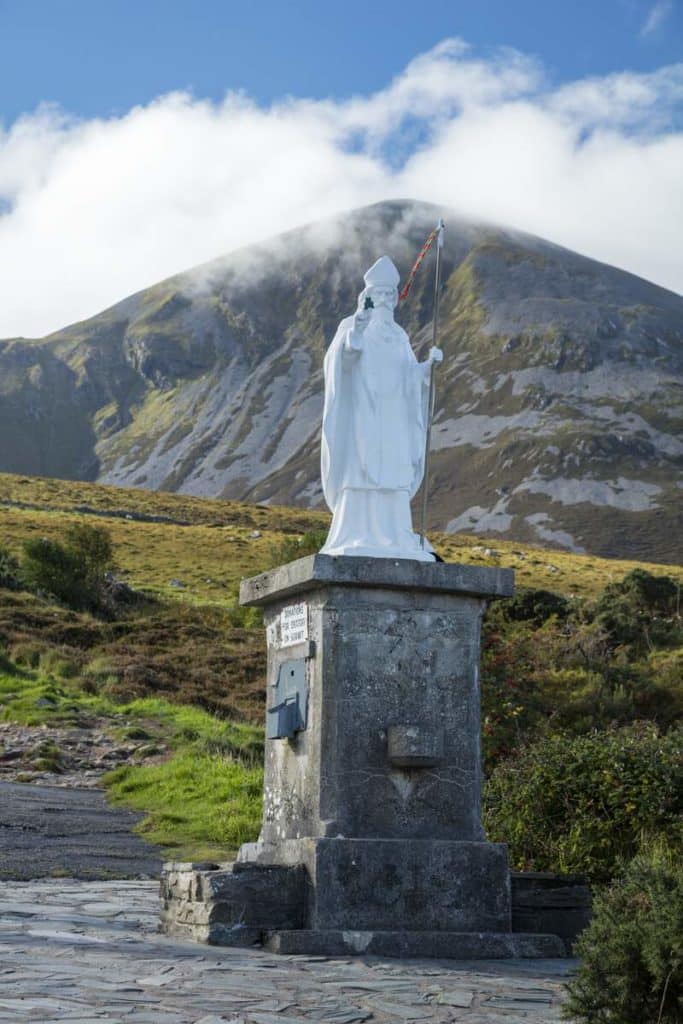
Section 2: St. Patrick’s statue to the shoulder (40 minutes -1 hour)
After passing through a small gate, the real hike starts. You’ll notice that in general the ground gets uneven, but the path is clear. As you look upwards, you’ll see how clearly defined the path is all the way to the top.
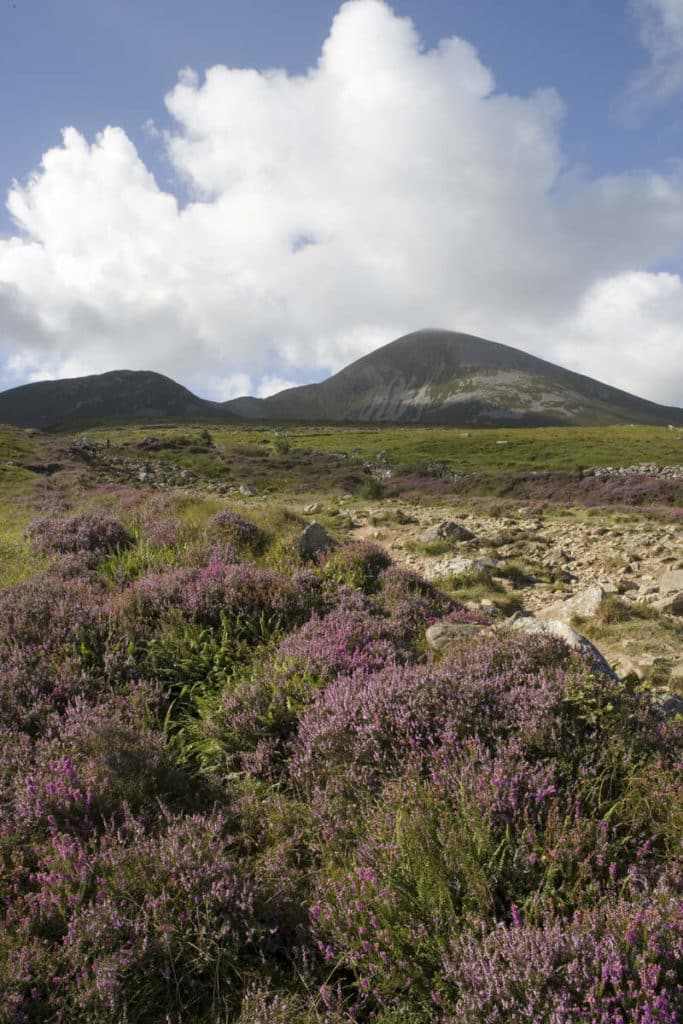
You’ll have the soothing sounds of a beautiful mountain stream to accompany you on the way up this section.
After a half an hour or so, you’ll encounter your first relatively steep section. Keep your eyes out for the serpentine minerals on some exposed rockfaces.
Take your time, get some water in and turn around every so often. The views are starting to get spectacular now. Clew Bay’s stunning contrast of blues and greens will keep you motivated.
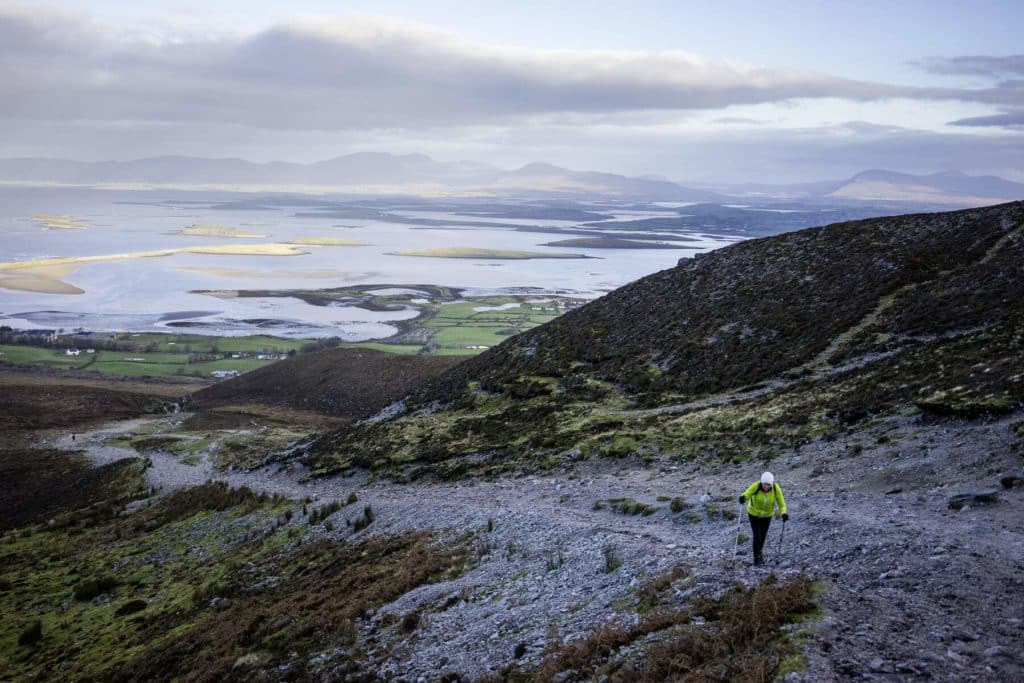
After a bit of a slog, you’ll be looking forward to reaching the next section ‘The Shoulder’.
When you have arrived at the start of this section, you have reached the halfway point of the hike. Once again have one quick look over Clew Bay. The next time you’ll see it will be from the summit.
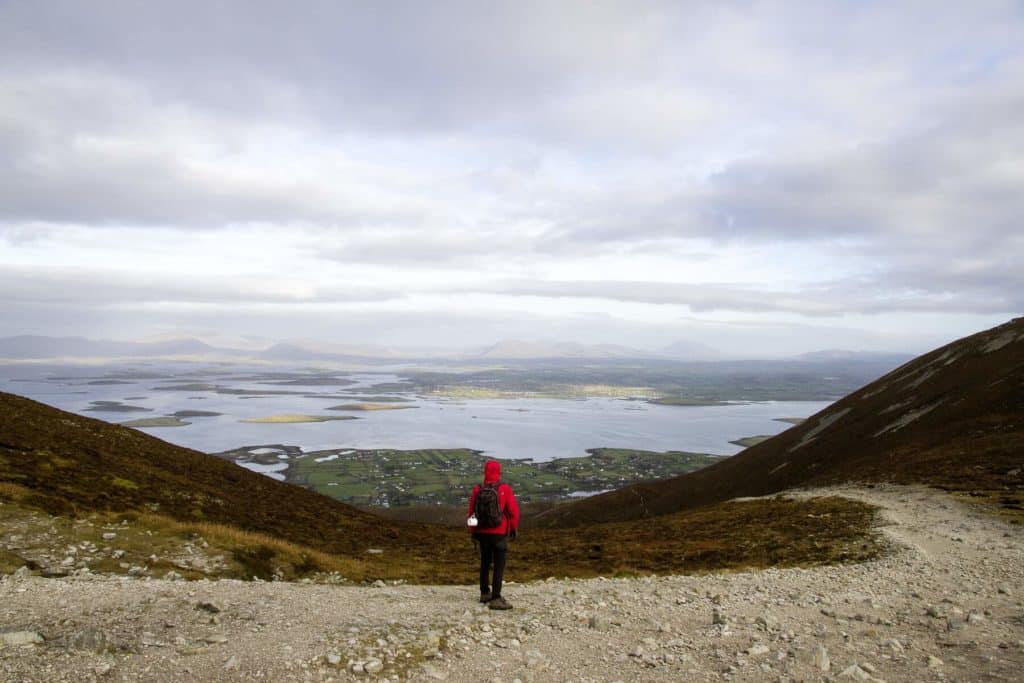
Section 3: From ‘The Shoulder’ to the base of the final peak (10 -15 minutes)
This is a grand section and seems almost strategically placed to help you catch your breath, rest your legs and get some water in.
There are toilets at this section and you’ll come across the ruins of a small stone oratory dating back 1,500 years.
At this section, it’s easy to think ‘sher, this hike is grand!’, but the hard part is yet to come…
Now that you’ve regained a bit of composure, you may notice some people climbing barefoot. This is actually quite a common sight on Croagh Patrick, with each person having their own individual reason for this act of penance.
Right, it’s time to take a deep breath, check your shoelaces and get ready for the final ascent. But first, let’s talk about the new path/steps.
New Path/Steps
You may have noticed up to now that certain trickier sections are pathed with steps.
This is due to the incredible work of the Croagh Patrick Path Team, who in recent years have, by hand, painstakingly built natural steps along the path.
As this process is utilizing the natural stone available, it fits in perfectly with the natural mountain environment, while assisting in preventing any further erosion from the 100,000 + visitors who climb Croagh Patrick annually.

The work creating these steps has to be highly commended and you’ll see and feel the fruits of their labour on the final ascent. This genuinely has made the climb safer.
Section 4: final ascent from base to summit: ‘The Cone’ (30 minutes to 1 hour)
Take your time here and take small steps. You may be inclined to take good, big steps so that you get over this section and get to the top as quick as you can.
Smaller steps will save you a ton of energy, preventing your body from overworking. The stick may be useful in this section.
The path gets narrow too, so just take your time if somebody is on the way down, and wait wherever you feel you have a good grip till they pass. Always know exactly where your next step will land.
After a good bit of huffing and puffing, you’ll begin to see the summit.
The first time I climbed Croagh Patrick, I thought I had already made it upon first sight of the top, but there was still a little way to go. Keep going, your reward is just 10 minutes away.
Summit
When you initially reach the summit, you’ll probably be overcome with a sense of relief, pride and sore thighs.
Take the short walk over to the far side and just take in that view…possibly the best in all of Ireland.
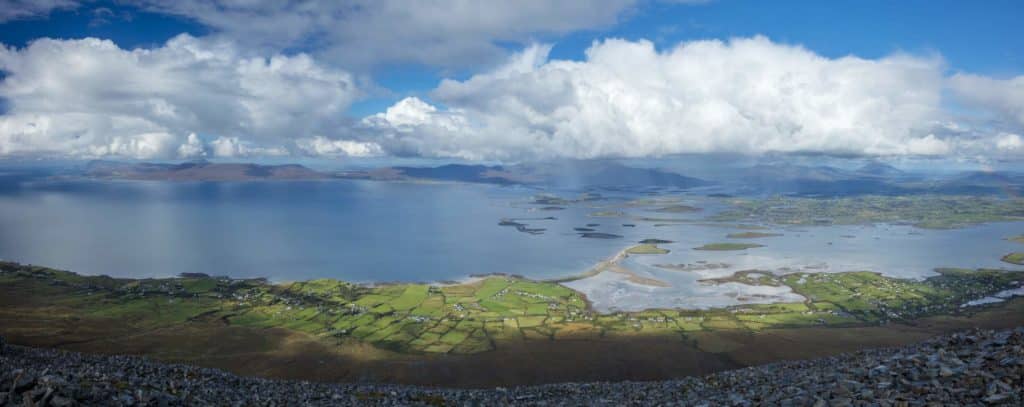
This massive vista over the hundreds of islands of Clew Bay and beyond will leave you breathless (again)
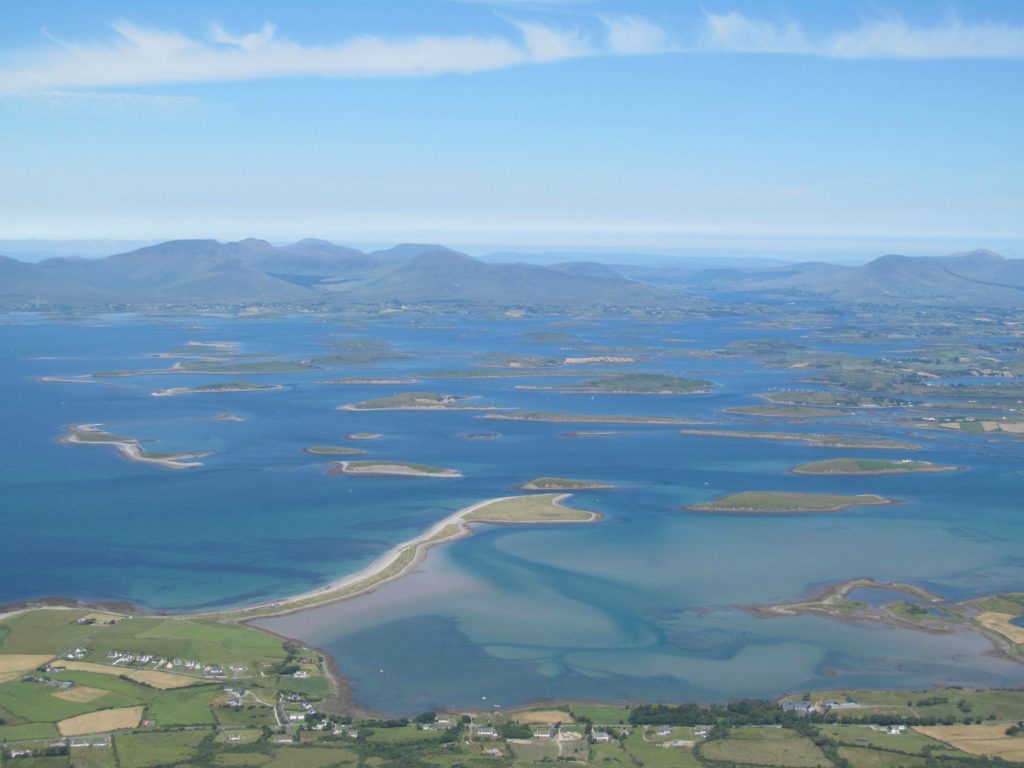
You’ll see to your left Clare Island, almost guarding the entrance to the bay and to the northwest Achill Island.
Take a look to the northeast and you may catch a glimpse of Ben Bulben in County Sligo. You’ll also notice the vast wilderness of the Nephin Begs directly to your north.
To your south, you’ll see the mountain range of the Sheeffry Hills with their iconic high plateaus. The Partry Mountains, along with Connemara’s 12 Bens are also to be seen, and closer to the coast, you’ll catch a glimpse of the Mweelrea mountains, Connaught’s highest.
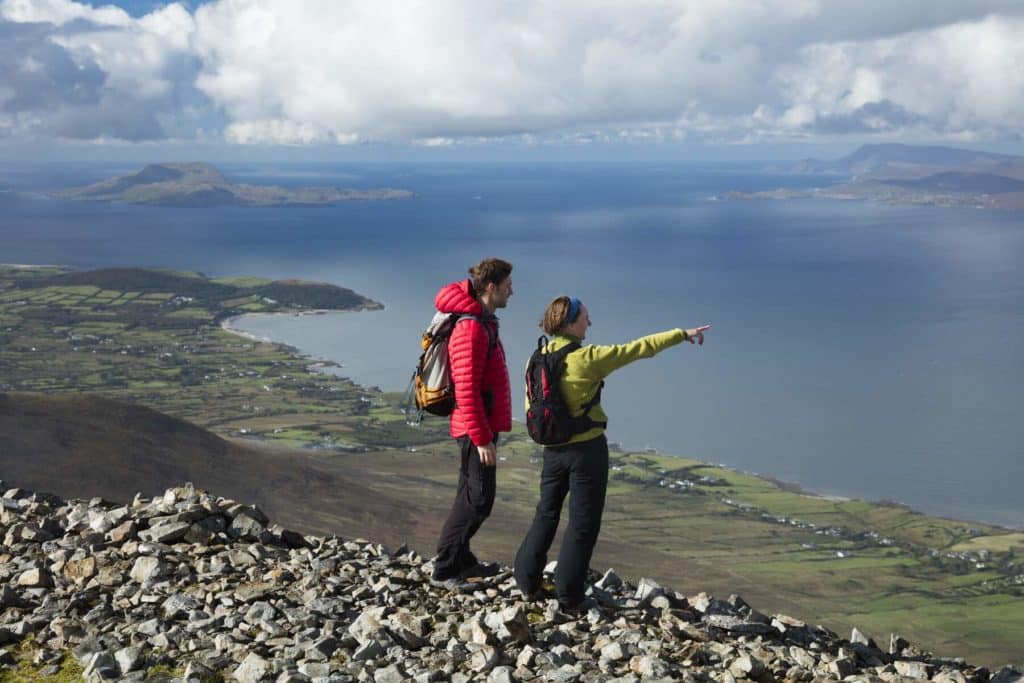
Maybe, you’re lucky and the chapel, St. Patrick’s Oratory, is open. Outside the chapel, you’ll see some welcoming little steps. Sit down, enjoy your sandwich and take in the views.
You’ll also notice St. Patrick’s bed, supposedly the spot where Patrick himself rested. Hard to believe the lengths he went to to test his faith…
Take as long as you need here, get some water in and when ready it’s time to make your way down again.
The Descent: a word of warning
If your stick has been a nuisance on the way up, you’ll find it’s absolutely necessary on your way down.
Most accidents on Croagh Patrick occur on the last steep section, during the descent. Take your time here, and do not rush.
When the narrow section of the path is over, zig-zag your way down to the bottom. Your knees will thank you for it later. Try to avoid any loose stones and plan each step carefully.
The middle section will once again give you a nice respite, but take care on the last section towards the statue of St. Patrick. Accidents happen here also, due to complacency.
Climb complete: you deserve a pint!
Well done you’ve conquered Croagh Patrick! Ready to do it barefoot the next time?!
Right next to the carpark, you’ll see Campbell’s, a lovely old pub with some mighty Guinness and some good hearty food to replenish your energy.
Have a look at their menu here. They also have a class beer garden out the back, making brilliant use of their shed in the summer months.
On the way back into town, along the main road you’ll find 2 excellent restaurants, namely The Sheebeen and The Tavern.
Both have an excellent menu and The Sheebeen in particular serve up some great seafood dishes, such as my own favourite: Clew Bay mussels.
My Croagh Patrick Climb: August 2023
During a brief spell of fantastic weather on the 9th August, 2023, I made the very most of it and got to experience Croagh Patrick for the 17th (possibly 18th?) time. What a completely new and incredible experience it turned out to be…
Now, I can’t say I know the mountain like the back of my hand, there a plenty who have climbed it more than myself. But I can vouch for saying I know Croagh Patrick very well and in particular the last, steeper section.
After my climb I was left with the feeling that this was a completely new hiking experience. The new steps reach to within a hair’s breadth of the summit now, thanks to the incredible work by the Path Team.
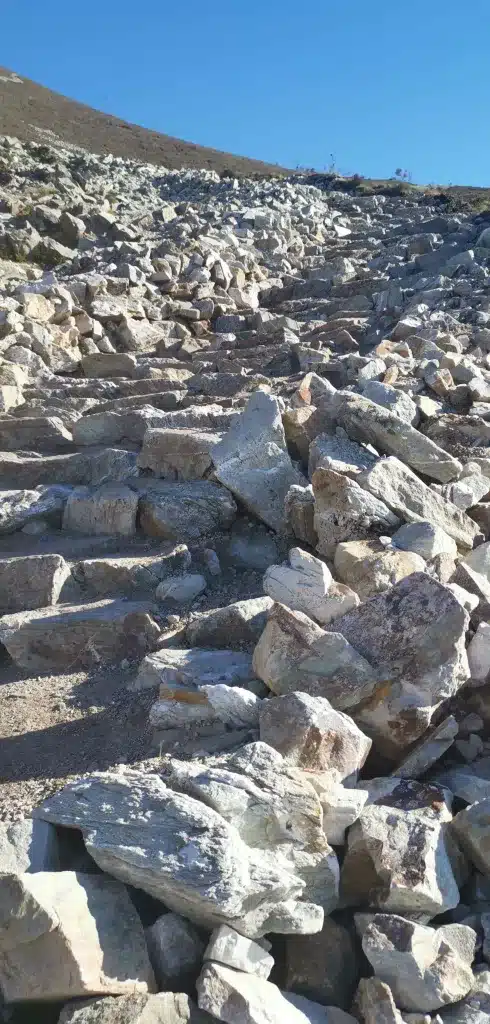
I am always cautious with statements like ‘the mountain is far easier and safer to climb now’, but it has made an enormous difference. The danger of slipping and the anxiety that went along with the last section has been eradicated.
You must of course still watch every step and respect the mountain!
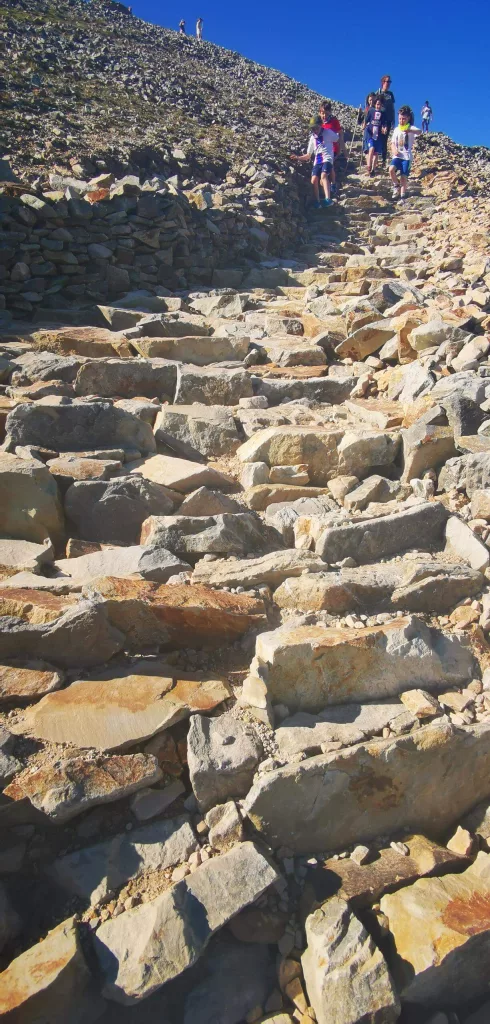
After a muggy start to the morning, the afternoon cleared and presented us with an almighty view from the summit. A sea fog had set in on Clew Bay, which gave the feeling of being 1000s of metres above sea level!
To my left were a young couple from Germany who, startled by the view, commented, ‘ich habe noch nie in meinem Leben so eine Aussicht gesehen’, which translates as, ‘I have never seen such a view in my life’.
I guess that sums up the holy mountain of Croagh Patrick, and to a greater extent the West of Ireland. When the sun shines, there really is nowhere like it.
Here, some photos of my experience:
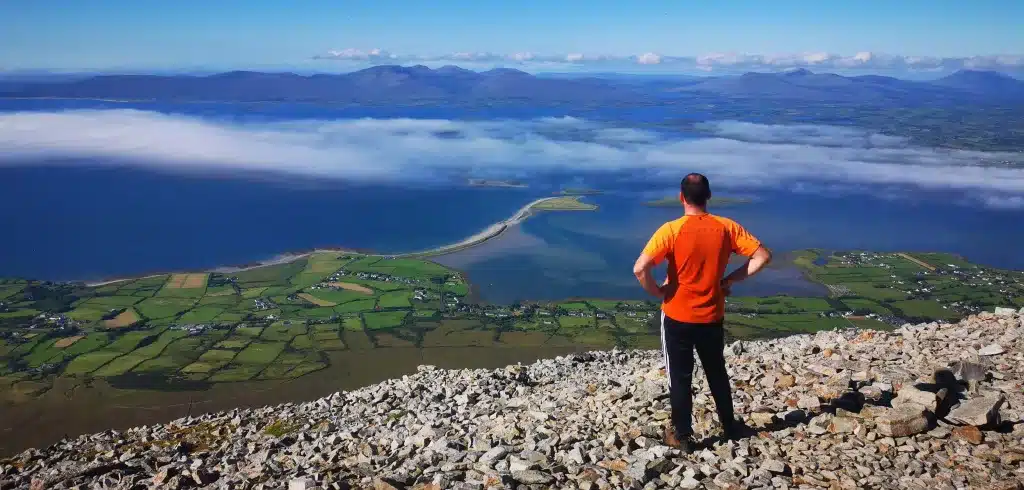
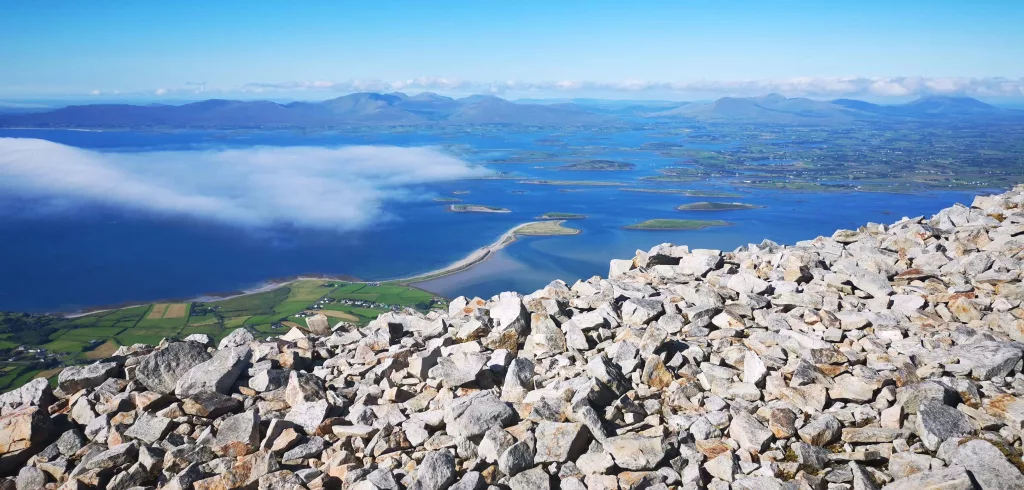
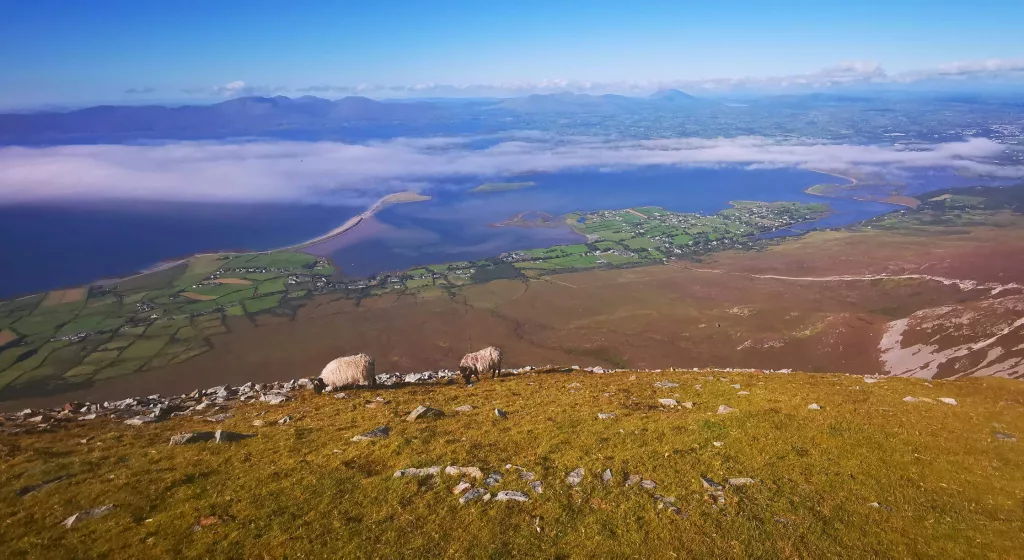
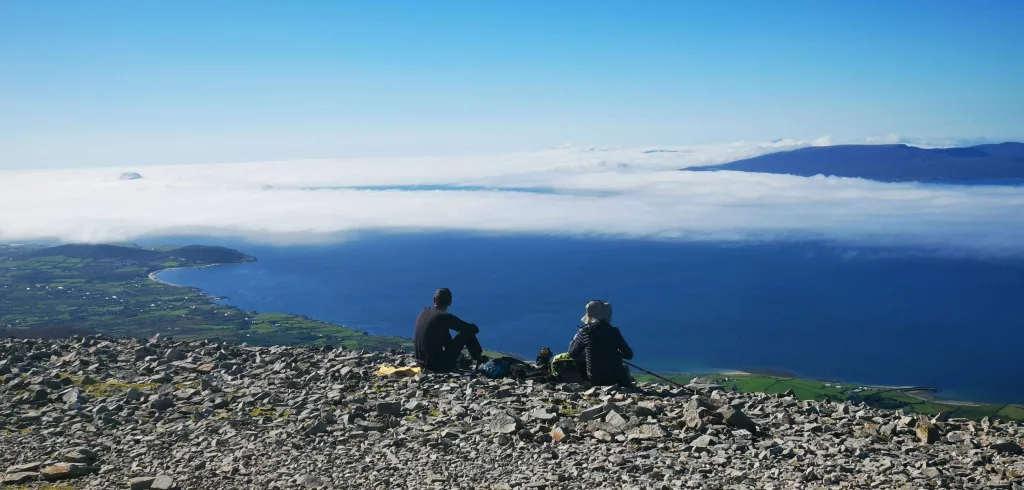
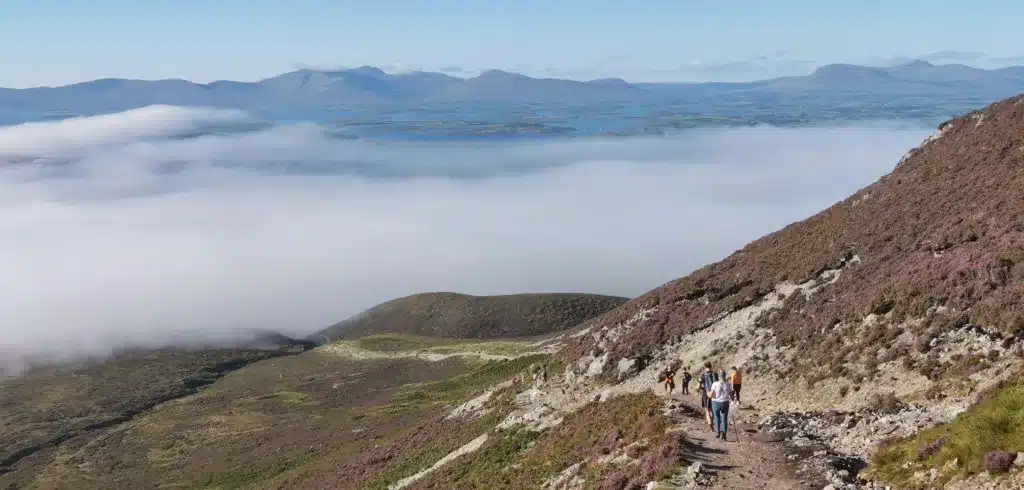
What to do after the climb
National Famine Memorial
Right across the road from the carpark, you’ll notice a ship-like statue. This is the National Famine Memorial, a stark reminder of the deeply traumatic event known as The Great Famine.
Between the years 1845 and 1852, mass starvation in Ireland lead to the death of over 1 million, while a further 1 million emigrated.
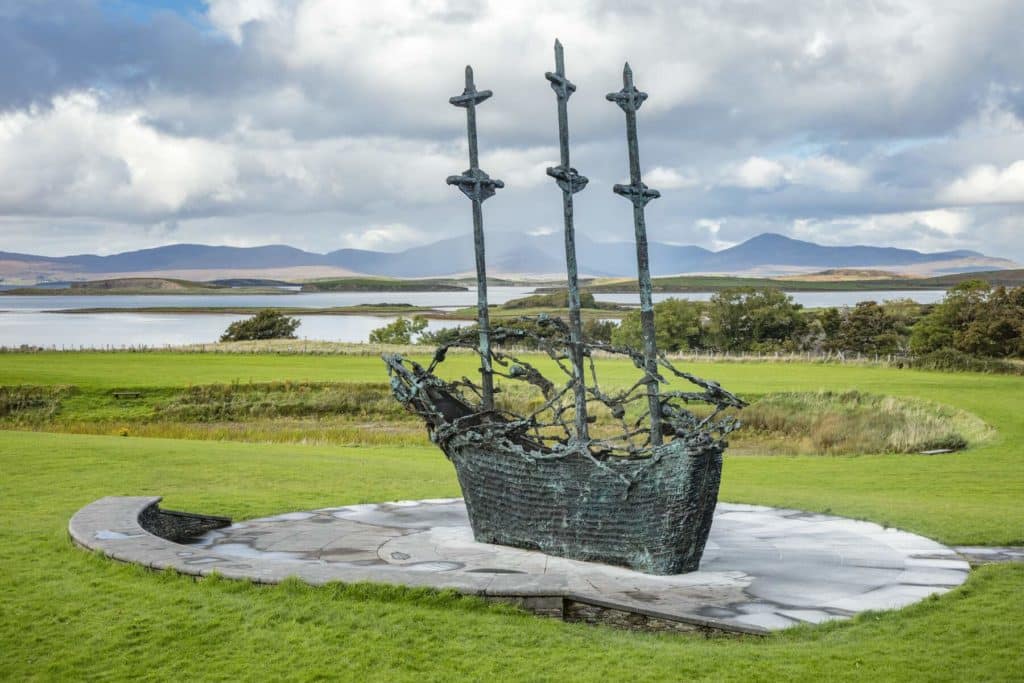
The sculpture itself on closer inspection will reveal some haunting skeleton bodies, in the rigging of the ship.
They symbolize the ‘coffin ships’, so called due to the appalling conditions those who the left the country had to endure on the boats, many of whom never reached American shores.
Murrisk Abbey
Looking for some more peace and serenity after just climbing Croagh Patrick? Just to the right of this memorial, you’ll see a laneway which will take you to Murrisk Abbey.
This abbey was founded in 1457 and although now in ruins, still stands strong at the edge of the Atlantic Ocean. The abbey was founded by the Augustinian Friars and you can find more details here.
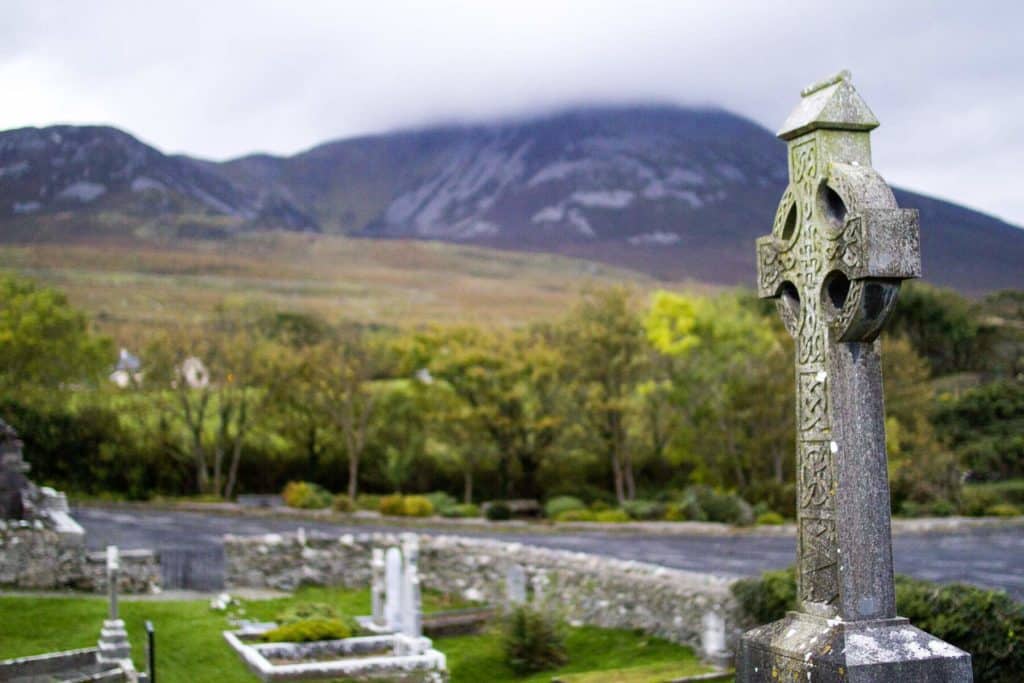
Soothe your feet in the waters of nearby beaches
Bertra Beach
Just down the road on the way to Louisburgh, you’ll find the glorious Bertra Beach. If the feet are feeling a bit swollen, what better place to get the blood going again.
You will also have a cracking view of Croagh Patrick from this strand.
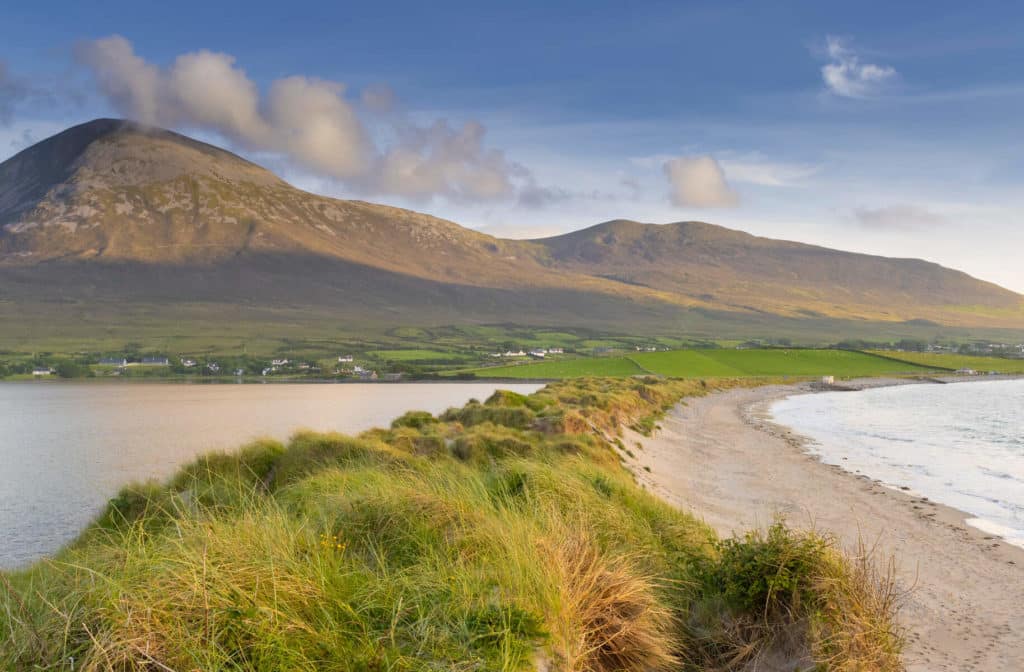
You can glance up at the mountain you have just conquered and with great pride, officially knock that hike off your Ireland bucket list… We actually have a full guide to Bertra Beach here, including tides and parking.
Old Head Beach
Is the tide fully in at Bertra? No worries, try Old Head beach down the road, near to Louisburgh.
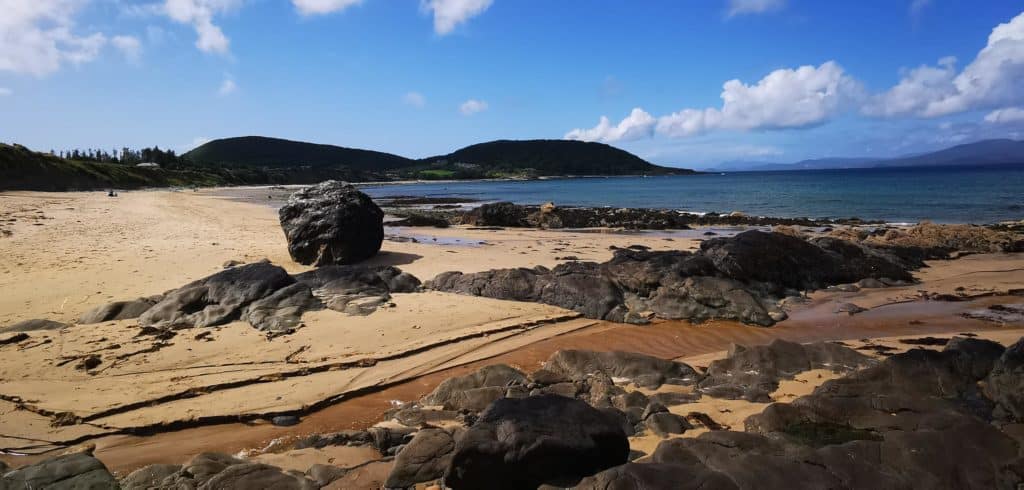
This is another stunning beach with equally as impressive views of Croagh Patrick, albeit from a different perspective. You can try paddle boarding here as well if you are still in the mood for action!
As luck would have it, we have a comprehensive guide to Old Head beach here.
Take a cruise on Clew Bay
Last year, as part of an epic day in Westport, we followed up our hike of Croagh Patrick with a sunset cruise on Clew Bay.
This is something that I won’t be forgetting any time soon. We were blessed with the weather and it capped off one of the best days I can remember for a long time.
As far as I know the sunset cruise only takes place in the summer months. We booked it online a few days in advance in the middle of August.
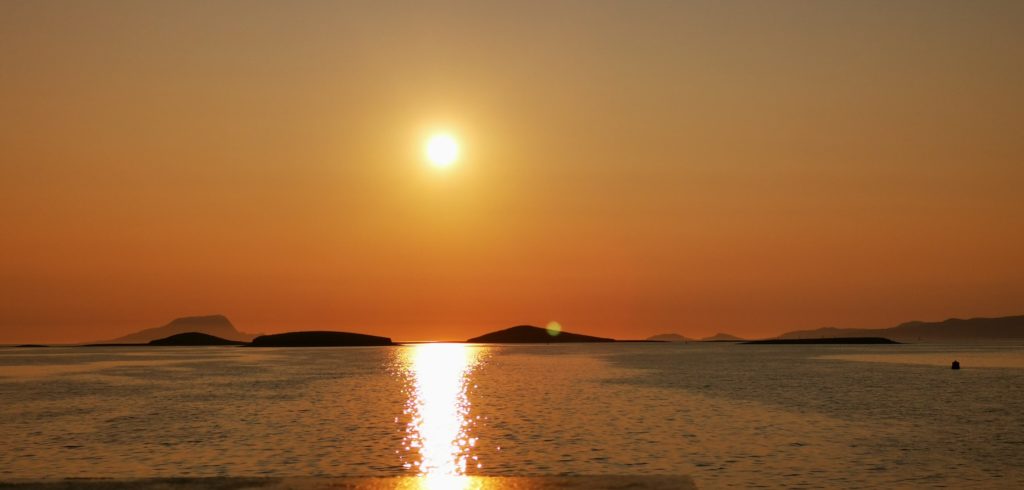
Sunset or not, it’s a beautiful way to spend a few hours. The tour is very informative, you’ll pass by the island John Lennon owned and you’ll spot some seals, along with majestic views of all the islands, and of course Croagh Patrick.
Click here for more details and photos.
What other walks are near Croagh Patrick?
There are plenty of good walks in the region. A nice alternative to climbing Croagh Patrick, but still with beautiful Clew Bay views, is the Murrisk Loop walk. This starts from the same trailhead and takes you just above the statue.
From here, you’ll walk along the lower slopes of Croagh Patrick and down to Murrisk pier and the beautiful Murrisk Abbey. This has become of of my favourite walks of late and is an excellent alternative for those not wishing to take on the whole mountain.
Where to stay near Croagh Patrick
Westport
The nearest main town is Westport. It’s colourful, vibrant, has some phenomenal restaurants and some equally brilliant pubs.
We have a detailed guide to Westport here.
We know this town like the back of our hands and we have also stayed in almost every hotel here!
Click here for our choice of the 12 best hotels in Westport.
Achill Island
Although not exactly nearby (approx. 1 hour by car), Achill Island (which is joined to the mainland by a bridge) is a place we highly recommend visiting.
From the highest cliffs to beaches which have been recognised worldwide, it’s a must see.
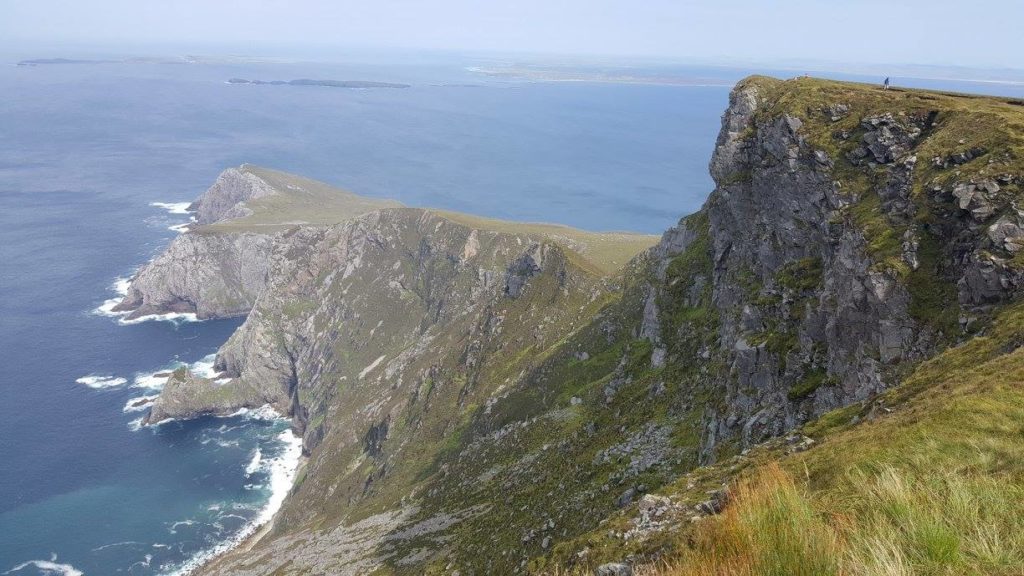
We have a comprehensive guide to Achill island here, along with a detailed accommodation guide here.
Final Thoughts
Top Tips For Climbing Croagh Patrick
Wear shoes that come up above the ankle, have a good grip and are waterproof. Croagh Patrick is not a mountain where you can just show up and decide to tackle with your jeans and runners! Although you probably will see the odd person doing this, we do not recommend.
If you are not used to wearing those hiking boots any more, buy a couple of blister plasters in the pharmacy in Westport. They’ll save a lot of heartache.
Either bring your own hiking poles or buy that stick in the car park. The difference it makes to your knees coming down from the mountain is incredible.
Choose a clear day with a high cloud ceiling. I tackled the mountain once on a cloudy, showery day and although I enjoyed it immensely, I missed out on the epic view from the top.
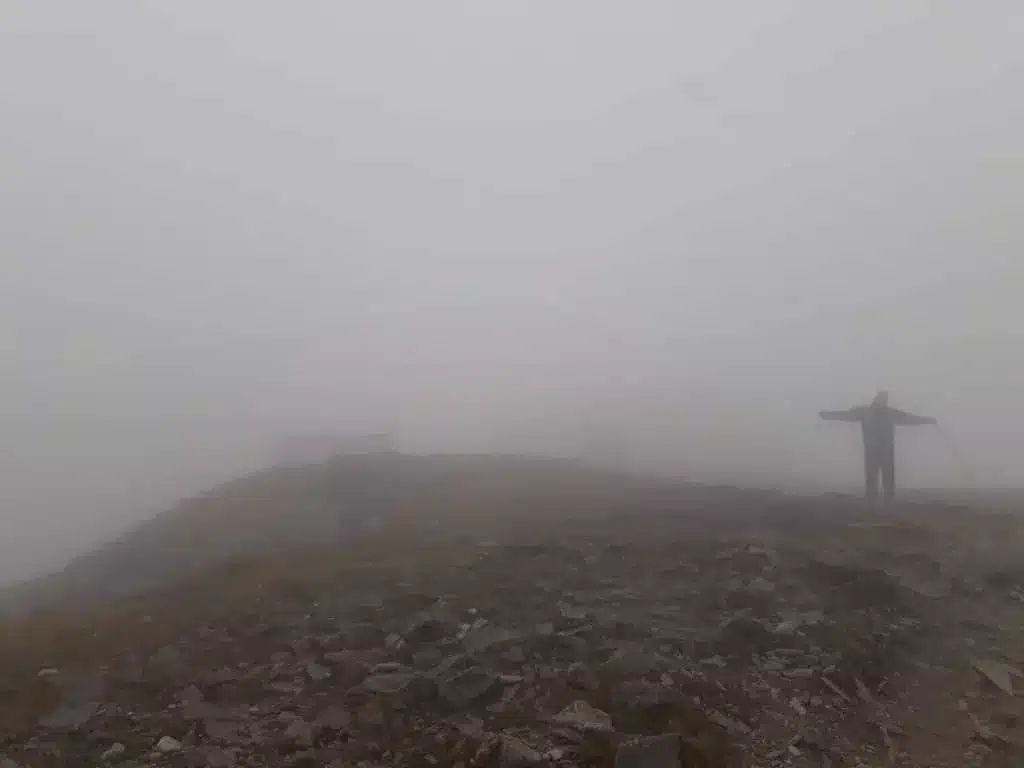
Always pack an extra layer, a light down jacket or so. A hat to cover your ears is also highly recommended as it can get fierce windy up the top.
On a bright day, the sun can be quite blinding, especially during the last section. The rocks and stones are bright in colour and being that bit higher up, there is more glare, so don’t forget you sunglasses. And don’t forget the sunscreen!
And last and by no means least: Unless you are an ultra runner, take your time and take it all in. Croagh Patrick is a very special place.
The views, the challenging climb, the air of peace and calm…all of these things equate to a truly magical day and one you won’t forget for many’s a year.
As a Mayoman, I’m proud that we are blessed with such wonderful nature in our county and that this mountain was left in its natural state after all the hullabaloo in the 1980s.
It’s vital we keep these places intact and leaving no trace after your day on the mountain is crucial. Bring any litter home or dispose of properly in the carpark.
Mayo is full of incredible hikes and the possibility for outdoor activities is phenomenal.
We hope you’ll get a chance to tackle the mighty Croagh Patrick and that our guide as helped you in some way. Please let us know below how you got on. Go n-éirí an bóthar libh!
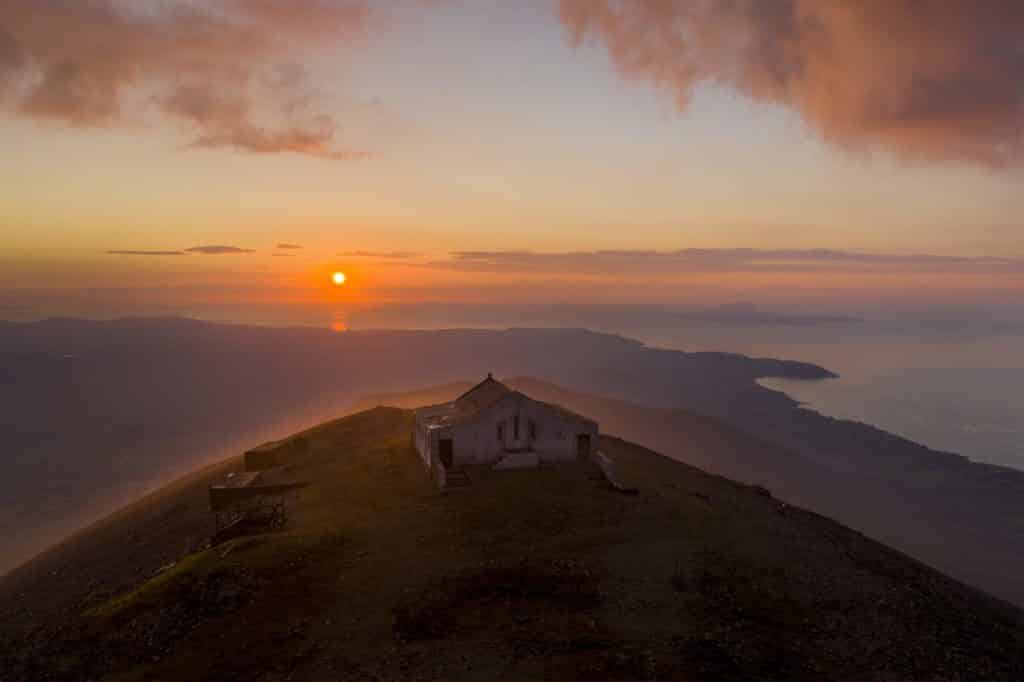
Other Hikes in the Region
Croaghaun Cliffs, Achill Island
Your Questions Answered
Are dogs allowed on Croagh Patrick?
No. Dogs are strictly not allowed on Croagh Patrick. Although thousands climb the mountain every year, the land is privately owned and is used for sheep farming.
Are there steps to the top of Croagh Patrick?
Yes, as of September 2023, the steps have been completed to the top of Croagh Patrick, making it a far safer climb and reducing further erosion of the mountainside.
How many kilometres is it to the top of Croagh Patrick?
From the car park at the trailhead, it is a distance of 5.5 km to the top of Croagh Patrick, with an elevation gain of 742 metres.
Is Croagh Patrick worth it?
Yes, Croagh Patrick is definitely worth it for its stunning views, and the historical and spiritual significance associated with the mountain. The spectacular views from the summit far outweigh the difficult trek to the top.
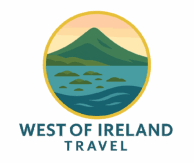
Hi,
Do you provide guiding services to Cloagh Patrick? If yes, how much do you charge for a group of 20?
Hi there Rita,
I have brought groups up Croagh Patrick numerous times in the past.
Please mail me at niallo301@gmail.com and we can discuss further.
Many thanks, Niall
Hi,
very nice article with great details.
can you recommend climbing Croagh Patrick in the winter season? Is snow on mountain in Dezember, January?
Greets,
Franz
Hi there Franz,
Thanks a lot for the positive feedback.
Absolutely! Winter can be an excellent time to climb. Sometimes there is a covering of snow on top but it rarely lasts long.
Croagh Patrick on a clear winters day is beautiful and you’ll have very few climbers.
Just be aware of the shorter daylight, so start the climb at the latest 12 midday to allow enough time.
Hope this helps,
Niall
I love this Post, its exactly how I remember it climbing up myself!
It really brings me back to my holiday in Westport.
Cheers!!
Debbie
Cheers Debbie!
Glad you enjoyed it. It’s certainly a great spot to go on holiday, can’t beat the craic in town and all the outdoor activities!
All the best, Niall
Pingback: Top 30 Instagrammable Places in Ireland You Shouldn't Miss